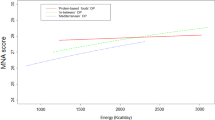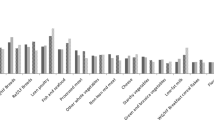Abstract
Background: Reliable information about the nutritional status of elderly people in Germany is lacking.
Objective: To describe energy and nutrient intake of elderly people living in private households in Germany with special focus on age-related differences in the elderly.
Design: Descriptive nationwide cross-sectional study.
Setting: Germany, 1998.
Subjects: A random sample of 4020 elderly men and women living independently in private households stratified in three age groups (65–74, 75–84, 85+ y), of which 1550 participated and 1372 (789 female subjects) provided reliable 3-day estimated dietary records.
Results: The median daily energy intake was 2207 kcal (9.2 MJ) in men and 1994 kcal (8.3 MJ) in women without difference between the age groups. Protein intake amounted to 91 and 81 g/day, respectively, corresponding to 1.2 g/kg body weight per day. The median intake was well above the recommended amount for all nutrients except dietary fibre, calcium, vitamin D and folate, where 38, 35, 75 and 37% did not reach two-thirds of the recommended amount. An age-related decline was observed for calcium intake in male and for dietary fibre, water, calcium, magnesium, iron, vitamins A, E, C and thiamin intake in female participants; however, the overall picture was unaffected by these differences.
Conclusions: Dietary intake in these independently living elderly, including the very-old, is adequate for most of the evaluated nutrients. Increased intake of foods rich in dietary fibre, calcium, vitamin D and folate as well as regular sunlight exposure is recommended in order to optimize nutrient supply in this population group.
Sponsorship: German Ministry of Health.
This is a preview of subscription content, access via your institution
Access options
Subscribe to this journal
Receive 12 print issues and online access
$259.00 per year
only $21.58 per issue
Buy this article
- Purchase on Springer Link
- Instant access to full article PDF
Prices may be subject to local taxes which are calculated during checkout


Similar content being viewed by others
References
Amorim Cruz JA, Moreiras-Varela O, van Staveren W, Trichopoulou A & Roszkowski W (1991): Euronut-SENECA: intake of vitamins and minerals. Eur. J. Clin. Nutr. 45(Suppl 3), 121–138.
Amorim Cruz JA, Moreiras O & Brzozowska A (1996): Longitudinal changes in the intake of vitamins and minerals of elderly Europeans. Eur. J. Clin. Nutr. 50(Suppl 2), S77–S85.
Arab L, Kohlmeier M & Schlierf G (1984): Bedarfsdeckung mit Mineralstoffen und Vitaminen: Ältere Menschen, In: Ernährungsbericht 198. ed. Deutsche Gesellschaft für Ernährung pp 59–65. Frankfurt/Main: Druckerei Henrich.
Bannerman E, Magarey AM & Daniels LA (2001): Evaluation of micronutrient intakes of older Australians: the National Nutrition Survey 1995. J. Nutr. Health Aging 5, 243–247.
Bates CJ, Prentice A & Finch S (1999): Gender differences in food and nutrient intakes and status indices from the National Diet and Nutrition Survey of people aged 65 years and over. Eur. J. Clin. Nutr. 53, 694–699.
Beaufrere B, Castaneda C, de Groot L, Kurpad A, Roberts S & Tessari P (2000): Report of the IDECG Working Group on energy and macronutrient metabolism and requirements of the elderly. Eur. J Clin. Nutr. 54(Suppl 3), S162–S163.
Brodhagen D (1993) Ernährungsaufklärung älterer Menschen Thesis, University of Gießen, Germany.
BgVV & Bundesinstitut für gesundheitlichen Verbraucherschutz und Veterinärmedizin (1996): Der Bundeslebensmittelschlüssel (BLS II.2) — Konzeption, Aufbau und Dokumentation der Datenbank blsdat. Berlin: BgVV-Hausdruckerei Dahlem.
de Groot L & van Staveren W (1988): Nutrition and the elderly. A concerted action on nutrition and health in the European Community, Manual of operations. EURONUT Report 11 The Netherlands: Wageningen.
de Groot LCPGM, Hautvast JGAJ & van Staveren WA (1991): Euronut-SENECA, Nutrition and the elderly in Europe. Eur. J. Clin. Nutr. 45(Suppl 3), 1–196.
de Groot LCPGM & van Staveren WA (1999): Older people, nutritionally related problems, In: Encyclopedia of Human Nutrition, eds. MJ Sadler, JJ Strain and B Caballero B, pp 1479–1485. London: Academic Press.
Eveleth PB, Andres R, Chumlea WC, Eiben O, Ge K, Harris T, Heymsfield SB, Launer LJ, Rosenberg IH, Solomons NW, Svanborg A, van Staveren W & Vellas B (1998): Uses and interpretation of anthropometry in the elderly for the assessment of physical status. Report to the Nutrition Unit of the World Health Organization: the Expert Subcommittee on the Use and Interpretation of Anthropometry in the Elderly. J. Nutr. Health Aging 2, 5–17.
German Nutrition Society (DGE), Austrian Nutrition Society (ÖGE), Swiss Society for Nutrition Research (SGE) and Swiss Nutrition Association (SVE) (2002): Reference Values for Nutrient Intake. Frankfurt/Main: Umschau/Braus GmbH.
Gloth FM, Gundberg CM, Hollis BW, Haddad JG & Tobin JD (1995): Vitamin D deficiency in homebound elderly persons. J. Am. Med. Assoc. 274, 1683–1686.
Gunzelmann T, Oswald WD, Rupprecht R, Hagen B & Tritt K (1996): Bedingungen der Erhaltung und Förderung von Selbständigkeit im höheren Lebens-Alter (SIMA) - Teil III: Stichprobe und Selektivität. Z. Gerontopsychol. Psychiatr. 9, 83–105.
Heseker H, Hartmann S, Kübler W & Schneider R (1995): An epidemiologic study of food consumption habits in Germany. Metabolism 44, 10–13.
Hébert R, Brayne C & Spiegelhalter D (1997): Incidence of functional decline and improvement in a communitiy-dwelling, very elderly population. Am. J. Epidemiol. 145, 935–944.
Holick MF (1994): McCollum Award Lecture, 1994: vitamin D — new horizons for the 21st century. Am. J. Clin. Nutr. 60, 619–630.
Holmes RP, Goodman HO, Hart LJ & Assimos DG (1993): Relationship of protein intake to urinary oxalate and glycolate excretion. Kidney Int. 44, 366–372.
Hurson M, Corish C & Sugrue S (1997): Dietary intakes in Ireland of a healthy elderly population. Ir. J. Med. Sci. 166, 220–224.
Itoh R, Nishiyama N & Suyama Y (1998): Dietary protein intake and urinary excretion of calcium: a cross-sectional study in a healthy Japanese population. Am. J. Clin. Nutr. 67, 438–444.
Löwik MRH, Westenbrink S, Hulshof KFAM, Kistemaker C & Jermus RJJ (1989): Nutrition and aging: Dietary intake of ‘apparently healthy’ elderly (Dutch Nutrition Surveillance System). J. Am. Coll. Nutr. 8, 347–356.
Marshall TA, Stumbo PJ, Warren JJ & Xie XJ (2001): Inadequate nutrient intakes are common and are associated with low diet variety in rural, community-dwelling elderly. J. Nutr. 131, 2192–2196.
Martins I, Dantas A, Guiomar S & Amorim Cruz JA (2002): Vitamin and mineral intakes in elderly. J. Nutr. Health Aging 6, 63–65.
McGandy RB, Russell RM, Hartz SC, Jacob RA & Tannenbaum S (1986): Nutritional status survey of healthy noninstitutionalized elderly: Energy and nutrient intakes from three-day diet records and nutrient supplements. Nutr. Res. 6, 785–798.
Mensink GBM, Thamm M & Haas K (1999): Die Ernährung in Deutschland 1998. Gesundheitswesen 61, S200–S206.
Mensink G, Burger M, Beitz R, Henschel Y & Hintzpeter B (2002): Was essen wir heute? Ernährungsverhalten in Deutschland. Beiträge zur Gesundheitsberichterstattung des Bundes. Berlin: Medien- und Kommunikations GmbH, Berlin.
Moreiras O, van Staveren WA, Amorim Cruz JA, Carbajal A, de Henauw S, Grunenberger F & Roskowski W (1996): Longitudinal changes in the intake of energy and macronutrients of elderly Europeans. Eur. J. Clin. Nutr. 50(Suppl 2), S67–S76.
Morse MH, Haub MD, Evans WJ & Campbell WW (2001): Protein requirement of elderly women: nitrogen balance responses to three levels of protein intake. J. Gerontol. A Biol. Sci. Med. Sci. 56, M724–M730.
Need AG, Morris HA, Horowitz M & Nordin C (1993): Effects of skin thickness, age, body fat, and sunlight on serum 25-hydroxyvitamin D. Am. J. Clin. Nutr. 58, 882–885.
Neuhäuser-Berthold M, Lührmann P, Herbert B, Sültemeier A, Hartmann B, Krems C & Breuninger M (2000): Ermittlung des Ernährungs Gesundheitsstatus von Senioren. Akt. Ernähr. Med. 25, 221–226.
Nicolas A-S, Faisant C, Nourhashémi F, Lanzmann-Petithory D, Tome D & Vellas B (2001): Nutrient adequacy of dietary intake in a healthy elderly French population. Eur. J. Ger. 3, 140–145.
Nydahl M, Andersson J, Sidenvall B, Gustafsson K & Fjellstrom C (2003): Food and nutrient intake in a group of self-managing elderly Swedish women. J. Nutr. Health Aging 7, 67–73.
Ritz P (2001): Factors affecting energy and macronutrient requirements in elderly people. Public Health Nutr. 4, 561–568.
Rothenberg E, Bosaeus I & Steen B (1993): Intake of energy, nutrients and food items in an urban elderly population. Aging Clin. Exp. Res. 5, 105–116.
Ryan AS, Craig LD & Finn SC (1992): Nutrient intakes and dietary patterns of older Americans: A national study. J. Gerontol. 47, M145–M150.
Sahota O & Hosking DJ (2001): The contribution of nutritional factors to osteopenia in the elderly. Curr. Opin. Clin. Nutr. Metab. Care 4, 15–20.
Schnell R (1997): Nonresponse in Bevölkerungsumfragen. Ausmaß, Entwicklung und Ursachen. Opladen: Verlag Leske & Budrich.
Schroll M, Ferry M, Lund-Larsen K & Enzi G (1991): Assessment of health: self-perceived health, chronic diseases, use of medicine. Eur. J. Clin. Nutr. 45(Suppl 3), 169–182.
Schroll M, Björnsbo-Schroll K, Ferry M & Livingstone MBE (1996): Health and physical performance of elderly Europeans. Eur. J. Clin. Nutr. 50(Suppl 2), S105–S111.
Sjörgen A, sterberg T & Steen B (1994): Intake of energy, nutrients and food items in a ten-year cohort comparison and in a six-year longitudinal perspective. Age Ageing 23, 108–112.
Statistisches Bundesamt (Federal Statistical Office) Wiesbaden (1999): Statistisches Jahrbuch 1999. Stuttgart: Metzler-Poeschel.
Steinmetz R (1978): Probleme der Ernährung Erwachsener im höheren Lebensalter. Ernährungs-Umschau 25, 35–37.
Thefeld W, Stolzenberg H & Bellach BM (1999): Bundes-Gesundheitssurvey: Response, Zusammensetzung der Teilnehmer und Non-Responder-Analyse. Gesundheitswesen 61, S57–S61.
van der Wielen RPJ, de Wild GM, de Groot LCPGM, Hoefnagels WH & van Staveren WA (1996): Dietary intakes of energy and water-soluble vitamins in different categories of aging. J. Gerontol. 51A, B100–B107.
van’t Hof MA & Burema J (1996): Assessment of bias in the SENECA study. Eur. J. Clin. Nutr. 50(Suppl 2), S4–S8.
Volkert D, Klaus L, Junk K & Stehle P (2001): Dietary assessment in the elderly: relative validity of a three-day estimated record. Ann. Nutr. Metab. 45(Suppl 1), 415 (abstract).
Wahlqvist ML, Davies L, Hsu-Hage BH-H, Kouris-Blazos A, Scrimshaw NS & Steen B (1996): Food habits in later life: a cross-cultural study. Melbourne: Asia Pacific Journal of Clinical Nutrition and United Nations University. (CD-ROM edition)..
Willett W (1998): Nutritional Epidemiology. New York, Oxford: Oxford University Press.
World Health Organisation (1985): Energy and protein requirements, Report of a Joint FAO/WHO/UNU Expert Consultation. Technical Report Series. no. 74 Geneva: World Health Organisation.
Wright AJA, Southon S, Bailey AL & Finglas PM (1995): Nutrient intake and biochemical status of non-institutionalized elderly subjects in Norwich: comparison with younger adults and adolescents from the same general community. Br. J. Nutr. 74, 453–475.
Acknowledgements
This study was supported by grants from the German Ministry of Health.
Author information
Authors and Affiliations
Contributions
Guarantor: D Volkert.
Contributors: DV designed and managed the nutrition survey, analysed the data, and wrote the article, KK analysed the data and co-wrote the article, HH designed the nutrition survey, PS helped to organise the survey and co-wrote the article.
Corresponding author
Rights and permissions
About this article
Cite this article
Volkert, D., Kreuel, K., Heseker, H. et al. Energy and nutrient intake of young-old, old-old and very-old elderly in Germany. Eur J Clin Nutr 58, 1190–1200 (2004). https://doi.org/10.1038/sj.ejcn.1601950
Received:
Revised:
Accepted:
Published:
Issue Date:
DOI: https://doi.org/10.1038/sj.ejcn.1601950
Keywords
This article is cited by
-
Consistency of supplied food and dentition status of the elderly in residential care homes
BMC Oral Health (2019)
-
Klimakterium und Berufstätigkeit
Zentralblatt für Arbeitsmedizin, Arbeitsschutz und Ergonomie (2017)
-
Non-invasive ventilation for acute hypercapnic respiratory failure in older patients
Wiener klinische Wochenschrift (2017)
-
Assessment of mineral intake in the diets of Polish postmenopausal women in relation to their BMI—the RAC-OST-POL study
Journal of Health, Population and Nutrition (2016)
-
Whole-body electromyostimulation to fight sarcopenic obesity in community-dwelling older women at risk. Resultsof the randomized controlled FORMOsA-sarcopenic obesity study
Osteoporosis International (2016)



